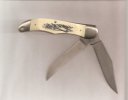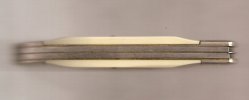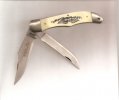And soooo that being said what about us newer,to collecting, folks we have the advantage? "NOT" just because you got "LOOTING" looted because of ,maybe some short sitghtedness, and now because of the demise of Schrade and the knives being more collectible people that have invested with hopes of appreciation have seen that hope come to fruition. No ill will toward you TennKnifeman but is your reply cause you ain't makin a furtune? I personally love the knives and any monatary gain is just icing on the CAKE!!!
Newer collectors for certain have the advantage today, because the prices have stabilized, rather than the ups and downs (and losses) that the collectors in the industry in the early days suffered. If you collect Schrades now is the ideal time to be getting in.
Please read what I said-- I said a run of 12,000 was too many then. It is too many now. A regular production run for some patterns in those days was 4000 or less, but because their knives said "collector" on them they were overpriced and overproduced, to the detriment of themselves, and to knife collecting in general.
Schrade in those days did the looting among the collectors by overproducing and overpricing the knives in comparisons to what they could have done. The long term effects were devastating to Schrade itself in my opinion. Instead of producing 12,000 knives the way they did, they could have changed a few handles, made fewer knives but a wider variety, and helped the knife business grow. The way Case handles their collectors today is a prime example how it COULD have been done. Case offers a nice newsletter, tour events, a wide variety of knives in lower quantities, and a very nice collector's event every other year in Bradford (not to mention a darn nice Case museum).
Instead Schrade went for the quick buck. And the knife business saw more than a few new collectors buy those knives at full retail, or dealer price, and watched their investment 20 years tank quicker than stock in Enron. And because of that they stopped collecting knives and started collecting something else.
Other companies kept their numbers down, started on shoestrings, and became major forces in the game. Fightn' Rooster, Bulldog first generation, Case Classics, Schatt & Morgan, Taylor Cutlery, and dozens of others got their start by keeping the quantities low and watching the collectors flock to them. In the early days that money could have gone to Schrade, they were in on the ground floor of the whole thing with the Kentucky Rifle, Kentucky Colonel, and Parker Eagle Set. But they didn't react and cut back quantities once the market became saturated.
If you only collect to please yourself that's ok, that's a true collector--but there aren't many of you out there. Most of us if we pay $30.00 for a collectible prefer it to be worth more at some point in the future, or at least worth our original $30.00 some 20 years down the road. It is a ego thing too. If I buy well, I feel bright rather than stupid. I've done both and I much prefer feeling bright.
I like seeing the knives I buy go up, and I do not enjoy them going down. It is very simple--if knife prices go up, more people are interested. The value of the knives you already own increases. Your net worth rises. Knife collecting expands. This is not a bad thing. A growing knife market with active and eager participants helps prevent the failure of factories like Schrade and Camillus.
Uncle Henry once described this to me as "our little business". And it is. I would much prefer it to be bigger, more vibrant, more active, with thousands of people crowding every knife show and event.
Let me say this more to the point.
It is my opinion if in the 70's and 80's Schrade had done more listening to the knife collector market and adapting to what the "market" needed rather than listening to what some suits in New York City that came to a knife show once a year, walked through without listening to to anyone, then went back to New York and did what they "thought" we needed, I believe there would still be a working Schrade factory in Ellenville cranking out knives.
I have made it my life's work to study the cutlery industry as an author, editor, publisher, dealer, auctioneer, and collector. I have no frustration about making or not making a fortune, I've been able to work in knives full time for those 30 years. I have no complaints.






